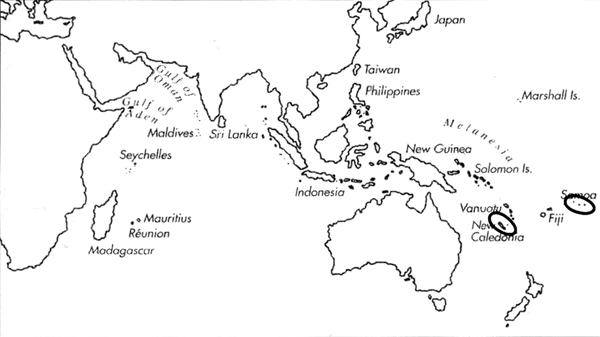
Skip Navigation Links
View access keys for this site.

Range: New Caledonia area; probably also Samoa.
Description: Small to medium-sized, light to moderately solid. Last whorl conical, sometimes conoid-cylindrical in populations from very shallow water; outline convex, or slightly convex adapically and less convex to straight towards base. Shoulder angulate and tuberculate, subangulate and weakly tuberculate in populations from very shallow water. Spire of low to moderate height; outline concave to convex. In southern New Caledonia, larval shell of 2.0-2.25 whorls; maximum diameter 0.7 mm in northern New Caledonia to 1 mm in the south. Postnuclear spire whorls tuberculate to weakly tuberculate. Teleoconch sutural ramps flat, with 1 increasing to 4-7 spiral grooves. Last whorl with variably spaced, shallow, punctate spiral grooves, sometimes from base to shoulder; spiral ribs usually granulose and restricted to abapical area or extending to centre or shoulder (form plumbeus) (Pl. 5, Fig. 31). Largely smooth specimens often with distinct non-granulose spiral ribs at shoulder.
| Shell Morphometry | ||
|---|---|---|
| L | 16-54 mm | |
| RW | 0.05-0.26 g/mm | |
| (L 19-45 mm) | ||
| RD | 0.57-0.67 | |
| PMD | 0.83-0.95 | |
| RSH | 0.09-0.20 | |
Last whorl various shades of brown, leaving variously shaped and sized white dots, spots, flecks or blotches, mostly located near shoulder and at centre, sometimes also at base. Brownish tones ranging from yellowish, orangish and olive-brown to dark reddish and blackish brown. Small individuals in northern New Caledonia (Pl. 5, Figs. 24, 25, 30) with small spirally arrayed white markings either extending across entire last whorl or restricted to central area. The medium-sized individuals in southern New Caledonia lighter in colour, with small to large white markings often fusing into 2-3 spiral bands or reduced to a few scattered dots or spots. Shells from very shallow water darkest in colour, with large, partially white markings, axially or spirally arranged. Base sometimes light violet. Larval shell white to pale yellow, pink in medium-sized shells from the south. Postnuclear sutural ramps matching last whorl in colouration (including number and size of white markings). Aperture of various shades of violet (southern population) or bluish violet to brown (other populations).
Periostracum thin and translucent.
In S. New Caledonia, animal red, dotted with white; siphon with sparse white dots at distal end. In the northern population, animal red, dotted with cream. In populations from very shallow water, animal red (Estival, 1981 & pers. observ.).
Habitat and Habits: In S. New Caledonia, C. exiguus known from coral, rubble, and coarse sand with algae in 13-53 m, often inhabiting channels of the barrier reef with strong water currents. In N. New Caledonia, a population with small shells is reported from similar habitats in 15-32 m. Moderately small, heavily flecked brownish black and white shells are more widly distributed in New Caledonia and more common in the north; the animals occur on coastal flats in 0.5-15 m, inhabiting dead corals and coarse sand bottoms (Estival, 1981; Tirard, pers. comm., 1989).
Discussion: C. exiguus as presented in this book may be a composite or complex of more than one species, but the common characters of its members are so distinctive that confusion with Indo-Pacific congeners is unlikely. Previous authors (e.g. Estival, 1981; Richard, 1990) suggested 2 to 5 (mostly 3) morphological species in this complex: 1, a southern form (cited as C. optimus by Estival) with strictly conical shells (RD 0.57-0.63; PMD 0.86-0.95) of medium size (35- 45 mm); 2, a relatively widely distributed form (C. cabritii of Estival) with moderately small (22-33 mm), conical to conoid- cylindrical shells (RD 0.57-0.67; PMD 0.83-0,92); 3, a northern form (C. bougei of Estival), of small shells (16-25 mm) with a conical last whorl (RD 0.60-0.65; PMD 0.85-0.90). Although we find that the shell characters of all intergrade, they may represent partially geographically differentiated populations. C. plumbeus (Pl. 5, Fig. 31) refers to completely granulose shells of this species. The type specimens of C. vayssetianus, C. taylorianus (Pl. 5, Fig. 29) and C. optimus (Pl. 5, Fig. 28) cannot be conclusively assigned to any of these forms, but all are within the range of variation of C. exiguus. Specimens recently found in Wesrern Samoa (Pl. 72, Figs. 14-15) are similar to form bougei.

C. exiguus Range Map
This section contains verbatim reproductions of the accounts of 316 species of Conus from the Indo-Pacific region, from Manual of the Living Conidae, by Röckel, Korn and Kohn (1995). They are reproduced with the kind permission of the present publisher, Conchbooks.
All plates and figures referred to in the text are also in Röckel, Korn & Kohn, 1995. Manual of the Living Conidae Vol. 1: Indo-Pacific Region.
The range maps have been modified so that each species account has it own map, rather than one map that showed the ranges of several species in the original work. This was necessary because each species account is on a separate page on the website and not confined to the order of accounts in the book.
Return to framed version (returns to search page)